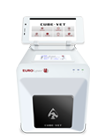Lipase (pancreatic) test
Pancreas monitoring
About the parameter
This assay is using the lipase enzymatic method DGGR, which is well known as a high-sensitive and specific method for detection of pancreatitis in animals.
It is a highly effective biomarker and has shown a >95% concordant by comparison with tissue and species specific quantitative immunoassay.
The combination of colipase and bile acid makes the reaction specific for pancreatic lipase without interference of esterases and lipolytic enzymes.
The measured absorbance is proportional to the lipase activity in the sample.
Overview
Sample material
20 µl fresh li-hep plasma or serum.
If samples should be stored ensure protection from light!
Sample material stability:
Stored at 2 – 8 °C – 2 days
Stored at -20 °C – 1 year
Measurement range
25 – 1200 U/L (Lot dependent)
Sensitivity: 25 U/L
Test duration
Test duration is approx. 5 minutes.
Package insert
More details can be found in the package insert.
Please note: All package inserts provided on this website are intended for information purposes only! Always process all tests, controls and calibrators strictly according to the package insert provided with the kit.
Appropriate instruments
 Eurolyser CUBE-VET |
 Eurolyser solo |
Evaluation
Test evaluation
Find the evaluation study for the Eurolyser lipase assay here: Eurolyser lipase test evaluation
Additional information
Article numbers
VT 0180 Lipase test kit (containing 16 tests)
VT 0181 Lipase test kit (containing 6 tests)
VT 1800 Lipase control kit (decision level)

